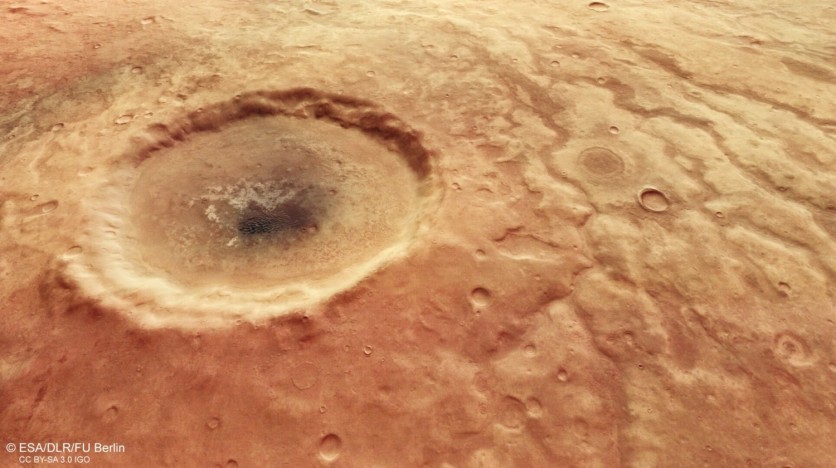A new image captured by the European Space Agency's (ESA) Mars Express highlights a strange-looking crater with a seemingly creepy eye.

A massive, city-sized unidentified crater leers on the surface of Mars well below the camera of Mars Express, with streaks of dark elements making it look like a gigantic eye glaring up at the stars.
However, the image's objective isn't to give you the creeps; but to provide satellite imagery that can help us better comprehend Mars' geology and history.
The Aonia Terra
The crater, which is 30 kilometers (18.6 miles) large, is located in the Aonia Terra region of Mars's southern hemisphere. It's deeply cratered, and the target of the new Mars Express photographs is far from the largest or most striking, and it's not far from the 200-kilometer-wide Lowell Crater.

According to Science Alert, enormous impacts carved out Lowell and many of the craters in the area around 4 billion years ago, during a destructive phase of the ancient Solar System called the Late Heavy Bombardment.
This is believed to be a similar case for our planet Earth, which was assaulted with atmospheric and seismic processes erasing much of the evidence from the planet's surface.
However, the data survived on Mars, which is desolate and geologically far quieter. It provides a tool for analyzing more chaotic periods in the Solar System's evolution.
Aonia Terra and other regions on Mars can also give information about the planet's makeup. A forceful impact gouges material normally hidden beneath the surface, resulting in new geologies and compositions on the surface.
The surface composition of the region depicted in the new photograph appears diverse and complex.
The nameless eye crater is located in topography hollowed out by channels, most likely formed billions of years ago by rivers of liquid water flowing across the surface.
Remnants of darker material may be observed in these channels, and some of them look to be raised - possibly as a result of erosion-resistant material settling in dehydrated riverbeds and surviving even when windstorms compromise the river's walls.
A Variety of Colors
This new photo, according to ESA, depicts a variety of colors on the surface around the crater, indicating that this region of Mars is made up of multiple elements as well.

Perspective view of crater in Aonia Terra
The surface is warm red located at the south of the crater, dissolving into a deeper brownish-grey closest to the crater. Many buttes may be seen in this area; these flat-topped rock towers are formed when land is progressively eroded away by water, ice, or wind.
Darker material may also be seen near the crater's core in the shape of a murky, undulating dune. Conical mounds and buttes can also be found in the crater, indicating that it serves as a form of the catchment for materials to be acquired.
Related Article : NASA's Perseverance Rover Records Mars' Soundscapes - Martian Playlist Available for Listening!
This article is owned by Tech Times
Written by Joaquin Victor Tacla
ⓒ 2025 TECHTIMES.com All rights reserved. Do not reproduce without permission.




